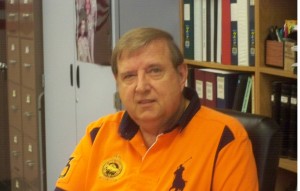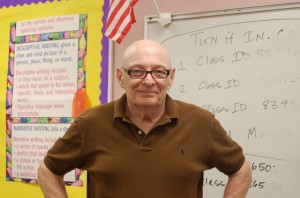A Salute to Veterans
November 5, 2014
Over the course of this nation’s history, America’s brave soldiers have valorously answered the call to defend our freedom, maintain peace, and drive away aggressors. As Veteran’s Day approaches, three of Diamond Bar High School’s teachers, Kurt Davies, Jim Salyer, and Joe Moran speak about their experiences in the military.
 Davies joined the Army when he was 19 following his family members who served in the military. With Desert Storm—the First Gulf War—on the horizon, Davies felt that it was an opportunity for him to serve his country.
Davies joined the Army when he was 19 following his family members who served in the military. With Desert Storm—the First Gulf War—on the horizon, Davies felt that it was an opportunity for him to serve his country.
“I always thought that it was a necessary step in growing up,” Davies said.
Davies served as a broadcast journalist in the Armed Forces Radio. After a few years, the military was offering early outs allowing Davies to return home and finish college.
“It was rewarding when the war was over to see how we were treated. We [returning soldiers] were really concerned because after Vietnam, people in the military were treated really poorly. So, it was nice to be thanked for our service,” Davies said.
Davies began coaching baseball, which sparked his interest in teaching. He loved the relationship he had with high school students and decided to become a teacher after majoring in Public Relations. Davies now teaches Modern World History at DBHS to freshmen and sophomores.
 Salyer, who was a First Lieutenant in the U.S. Army Artillery, enlisted in September of 1966 during the Vietnam War because he had the opportunity to become an officer in the U.S. Army. Salyer also served as a Casualty Notification officer who was responsible for military funerals and family assistance for those who died in the war.
Salyer, who was a First Lieutenant in the U.S. Army Artillery, enlisted in September of 1966 during the Vietnam War because he had the opportunity to become an officer in the U.S. Army. Salyer also served as a Casualty Notification officer who was responsible for military funerals and family assistance for those who died in the war.
“Adapting to military life was not hard, as my father was a career Navy officer. [However,] my tour overseas was very difficult, as I lost friends,” Salyer stated via email.
Salyer went through basic training at Fort Ord, Advanced Training Combat Engineers at Fort Leonard Wood, and Army Officers Training at Fort Sill. He then was trained to receive top secret clearance certifications in radio communications procedures.
After taking part in a tour in Vietnam, Salyer resigned his commission in September of 1969 and joined the California Highway Patrol attaining the rank of Sergeant. Due to an accident in his line of duty, Salyer decided to retire from the CHP. He now teaches two ROP Administration of Justice classes and four World History classes at DBHS.
“When I retired from the CHP, I chose to complete a degree in social science because I enjoy teaching young people about our justice program,” Salyer said.
 Another veteran from the Vietnam War, Moran volunteered to enlist in the U.S. Marine Corps along with two of his friends in 1966.
Another veteran from the Vietnam War, Moran volunteered to enlist in the U.S. Marine Corps along with two of his friends in 1966.
“I probably would’ve been drafted anyway. We [friends] fell in with the hype that everyone else had that the Marines were the best. So I did, and it wasn’t a very well thought-out decision,” Moran said.
He took his basic training in Parris Island in South Carolina and in Camp Lejuene in North Carolina. Moran then was moved to Camp Pendleton in Oceanside and went through advanced training. Soon after that, he was deployed to Vietnam for about 15 months joining the artillery battery 105 Howitzer—a unit of short barreled cannons used to facilitate battle control and communications.
When Moran came back home unscathed, he worked in Camp Lejuene as a Supply Sergeant for several months because he was a short timer, a soldier whose enlistment time is almost up. During that time, Moran went on a Caribbean Cruise—not for relaxing but with the Seventh Fleet. Moran was discharged in 1969.
“I don’t have any regrets. I learned about myself, my ability to endure certain things,” Moran said.
He then worked for the Pan American Airways until it went bankrupt in 1991. Moran never planned to become a teacher. However, because he already had an English degree, Moran decided to try a new career; he obtained his Masters Degree in teaching and started when he was 38 years old. He now teaches English I Honors and AP Language and Composition at DBHS.


